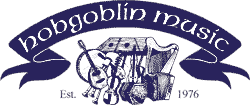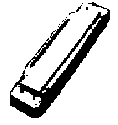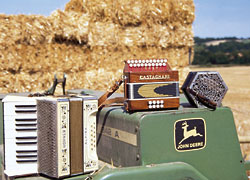
| THE HOBGOBLIN INFO SOURCE | |||
| HOBGOBLIN INDEX PAGE | HOBGOBLIN INFO INDEX | CATALOGUE CONTENTS | HARMONICA ONLINE SALES | |
| Harmonica FAQ | ||||
 |
ON THIS PAGE: Harmonica Origins About Cross Harp |
 | ||
|
© Copyright Hobgoblin Music 1983, 2000. This text may be freely distributed in whole or in part so long as the copyright holder is clearly acknowledged. Harmonica OriginsThe Harmonica first appeared in Europe around 1820 when various inventors began developing existing free reed instruments such as the sheng. Although initially designed for playing European folk music, It soon found a place in a wide variety of genres - becoming synonymous with the Blues and other emerging American music. The Harmonica also suited itself perfectly to mass production, making it the instrument of choice for the American poor and earning it almost instant success and iconic status! Modern music has also embarced the Harmonica and its folksy, outlaw image. Popular culture figures such as Bob Dylan and Neil Young have ensured that it remains one of the most widely loved of instruments! There are many types of Harmonica, from the most common; The ten whole Diatonic Harmonica (The one you think of when you think of a Harmonica) to elaborate orchestral Harmonicas, gimmicky wierd Harmonicas and specialist Harmonicas with odd tunings and appearances! About Cross HarpThe 10 hole Diatonic Harmonica, used by most Blues players is usually tuned to a major scale. Each Harmonica is marked with the key of the Major Scale to which it is tuned. A Harmonica player, playing the notes of the Major scale, over a piece of music in the marked key of that Harmonica is said to be playing in "straight harp", or "first position". That is to say, to play "straight harp" over G, you need a Harmonica tuned to the scale of G major.
However, the characteristics of, for example, Blues Music demand that the player is able to achieve notes not available in a normal Major scale, such as the flattened seventh tone and sharpened 2nd. Therefore, to play Blues, you need a Harmonica in a differant key to the key of the song. A Harmonica marked in a key a perfect 5th below the key of the song will provide the sharpened and flattened tones needed to produce this Bluesy sound. Therefore, to play Blues in G, you need a Harmonica marked in C major.
If that did not make much sense to you, dont worry, you'll understand soon enough! (Its all about Major scales).
Back to the Top of the Page |